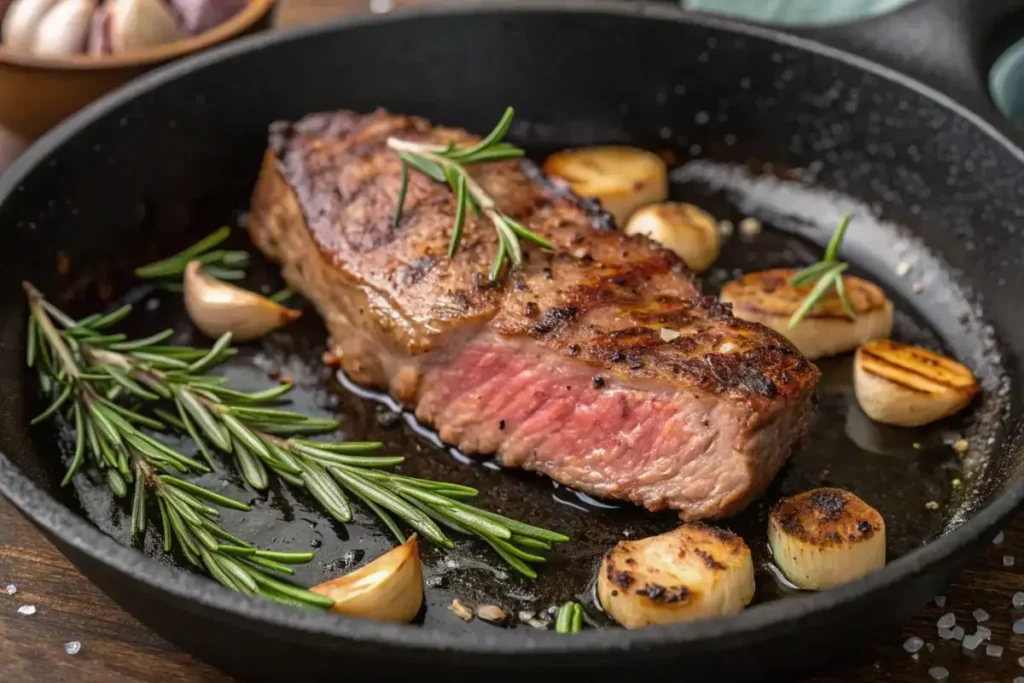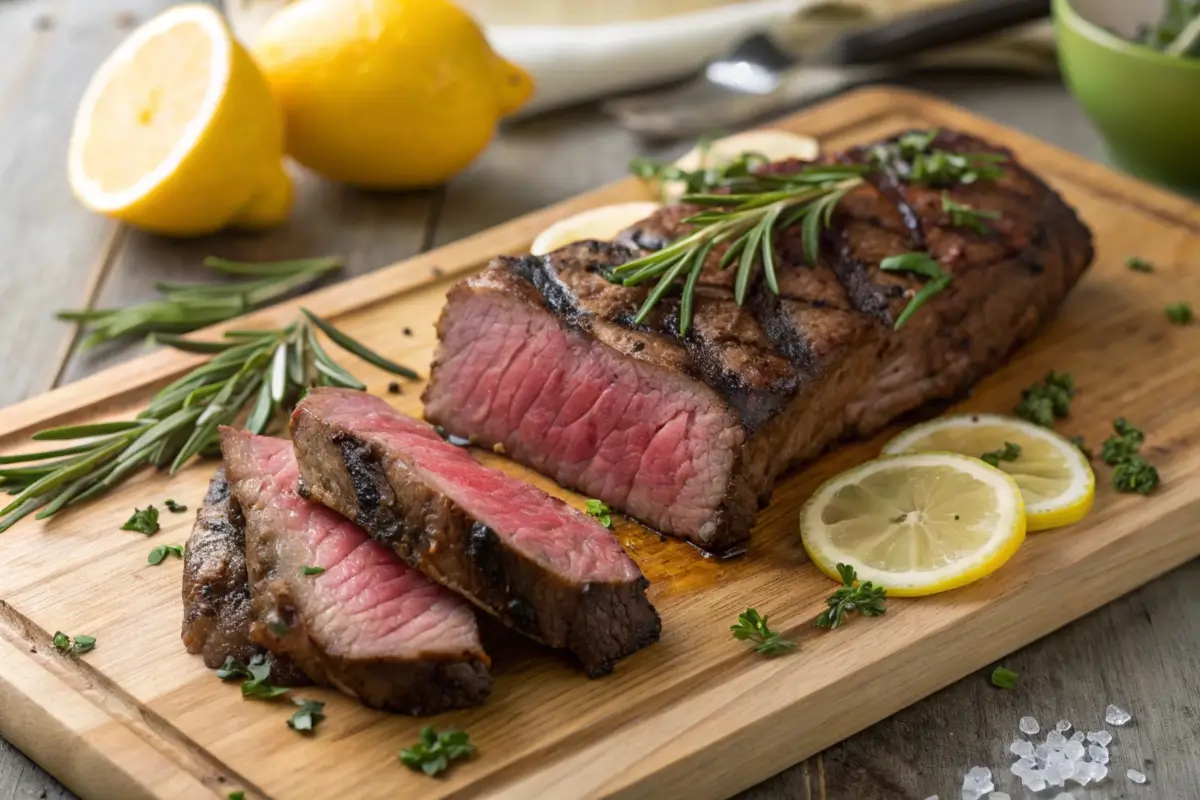Table of Contents
When it comes to steak, most people are familiar with the big names like ribeye, sirloin, or filet mignon. But have you ever heard of the teres major steak? This delicious cut is often overlooked, hiding in the shadows of more popular steaks. But for those in the know, it’s a hidden gem that’s worth exploring! Let’s dive into what makes the teres major steak so special.
What is Teres Major Steak?
The teres major steak comes from a small muscle located in the shoulder region of the cow, specifically from the chuck area. Although it’s not widely recognized, it offers a flavor profile that closely resembles filet mignon, making it a fantastic alternative for steak lovers looking for something new and exciting.
Imagine a world where any muscle could transform into a juicy steak. That’s basically what the teres major does! It’s like the mysterious sidekick to the more popular leading roles in the steak world. But why should this cut receive more attention? Let’s find out!
Anatomy of the Teres Major Muscle
Let’s geek out for a moment! The teres major is a relatively small muscle (usually only about 1 to 2 pounds). It plays an important role in the movement of the shoulder. If you’re picturing a cow doing shoulder presses in the gym, you might be onto something!
This muscle has just the right amount of tenderness and a rich flavor profile due to the way the cow uses it. Not too tough, not too soft—think of it as the Goldilocks of steak cuts. Plus, with its close tie to the chuck, it comes packed with juicy richness that makes it so delicious.
Teres Major vs. Other Steaks: A Comparison
Now, let’s compare our star, the teres major, to some of its flashier counterparts. If you’ve ever tried a filet mignon, you know that it’s known for its buttery softness and delicate flavor. But guess what? The teres major is actually more budget-friendly while still delivering a punch of flavor!
Here’s a quick rundown of how the teres major stacks up against some popular cuts:
| Steak Cut | Flavor | Tenderness | Price (per pound) |
|---|---|---|---|
| Teres Major | Rich | Very Tender | $8 – $12 |
| Filet Mignon | Buttery | Extremely Tender | $20 – $30 |
| Ribeye | Beefy | Tender | $15 – $25 |
| Sirloin | Well-rounded | Moderate | $10 – $20 |
With its affordable price and delicious flavor, the teres major is definitely the underdog of the steak world. And who doesn’t love a good underdog story?
Flavor Profile of Teres Major Steak
So, what does teres major actually taste like? To put it simply, it’s a flavor explosion that’ll have your taste buds dancing! It’s juicy with just the right amount of marbling, which gives it that delicious richness we all crave. Picture this: sinking your teeth into a steak that’s both tender and bursting with flavor.
Texture and Tenderness
Since teres major is a muscle that doesn’t get much exercise, it’s surprisingly tender. Unlike tougher cuts that require long cooking times to break down the fibers, this muscle can be cooked relatively quickly to maintain its natural tenderness.
I like to think of it as the “easygoing” friend in a group: it doesn’t put up a fuss and is always ready to go for a quick dinner. The texture is smooth, making it perfect for quick grilling or pan-searing.
Ideal Cooking Methods
Now that we know what the teres major tastes like, let’s chat about cooking methods! The beauty of this cut is its versatility. Here are a few ways to cook it to perfection:
- Grilling: This is a fantastic way to get those beautiful grill marks and smoky flavor. Season it simply with salt and pepper, or you can use a marinade to ramp up the taste.
- Pan-Seared: If you prefer cooking indoors, pan-searing is your friend. Sear it in a hot cast-iron skillet and finish it in the oven for a gorgeous crust.
- Sous Vide: For the cooking enthusiasts willing to dabble in precision, sous vide cooking allows you to control the temperature to maintain the ideal tenderness while infusing flavors.
If cooking were a party, the teres major steak would be the life of it—flexible, fun, and always ready for something delicious!
How to Choose the Perfect Teres Major Steak
Now that we’re all excited about teres major steak, let’s make sure you’re choosing a top-quality cut when you’re out shopping. After all, a good steak deserves the best!
Where to Buy Quality Teres Major Steak
You can typically find teres major at local butcher shops or specialty meat markets. These places often have a more diverse selection than your average grocery store, which might not carry less common cuts. Keep in mind that freshness is key!
When shopping, don’t hesitate to ask your butcher for advice. They can give you tips on selecting the best teres major, and they might even be able to cut it fresh just for you.
What to Look For: Marbling and Color
When selecting your cut, pay attention to the marbling—the little lines of fat running through the meat. Marbling is essential for flavor and juiciness. You want a steak with a good amount of marbling, which will melt during cooking and enhance the overall taste.
Also, take a look at the color. A fresh teres major will have a bright red hue. If it looks a bit dull or brownish, it might not be the freshest option on the shelf.
Block Quote
“Choosing the right steak is like finding the right pair of shoes; comfort and style should always be your focus!”
Preparing Teres Major Steak for Cooking
You’ve got your teres major steak; now it’s time to prepare it for cooking. This is where the magic starts!
Essential Marinades and Seasonings
While teres major has its own fantastic flavor, a little seasoning goes a long way in bringing out its best qualities. You can choose to go with simple seasonings or jazz it up with a marinade.
Simple Seasoning Mix
- Salt
- Black pepper
- Garlic powder
This classic seasoning blend enhances the steak’s natural flavors without overpowering it.
Marinade Ideas
Using a marinade can help tenderize the meat and infuse it with flavor. Try mixing some of these ingredients for a quick marinade:
- Soy sauce
- Olive oil
- Lemon juice
- Honey
- Fresh herbs like rosemary or thyme
Just whisk them together, toss in your steak, and let it marinate for at least 30 minutes. But if you have the time, marinating overnight will take the flavor to the next level!
The Importance of Resting Meat
Once your steak is grilled or seared, it’s crucial to let it rest for a few minutes before slicing. This helps the juices redistribute within the meat, ensuring every bite is as juicy as possible. Imagine biting into a dry piece of meat—no thanks! By allowing the steak to rest, you’re setting yourself up for a mouthwatering experience.
Cooking Teres Major Steak: Techniques & Tips
Alright, let’s get down to the fun part—cooking your teres major steak! Whether you’re firing up the grill or sizzling it in a pan, I’ll share some tips and techniques to turn you into a steak maestro!
Grilling the Perfect Teres Major Steak
Grilling is one of the best ways to cook teres major steak. Imagine the aroma wafting through the air, the sound of sizzling meat, and those famed grill marks. Here’s how to get it just right!
- Prep the Grill: First things first, make sure your grill is nice and hot. You want those high temperatures to create a beautiful crust on the outside.
- Season Generously: You’ve already marinated or seasoned your steak, right? If not, do it now, and remember: don’t be shy with the salt and pepper.
- Direct Heat: Place your steak on the grill over direct flame. Cook it for about 4-5 minutes on one side without moving it. Flip it and do the same on the other side.
- Check for Doneness: Use a meat thermometer to check the internal temperature. For medium-rare, you’ll want to aim for about 130°F (54°C).
- Rest it Up: After pulling it off the grill, allow the steak to rest for at least 5 minutes. This step is essential for maximizing juiciness.
Doesn’t that sound easy? Just like throwing a BBQ party in your backyard, grilling teres major adds a special touch to any meal.
Pan-Seared Method
If grilling isn’t your style (or you can’t do it), the pan-seared method is a fantastic alternative. You can achieve that tasty brown crust right on your stovetop!

- Choose Your Pan: A cast-iron skillet is perfect for this. It heats evenly and retains that heat beautifully.
- Preheat: Heat your skillet on medium-high until it’s hot. You can add a splash of oil with a high smoke point (like canola or avocado oil).
- Sear and Flip: Place your seasoned steak in the hot skillet and sear for around 4 minutes. Flip and sear the other side for another 3-4 minutes.
- Finish in the Oven (Optional): If your steak is thick or you’re aiming for a perfect medium or medium-well finish, transfer it to a preheated oven at 400°F (200°C) for a few minutes.
- Let it Rest: Just like grilling, let it rest once you take it out. By allowing the juices to settle, every forkful will be spectacular!
Pan-searing can be like a cozy hug in cold weather—comforting and always satisfying!
Sous Vide Cooking: A Beginner’s Guide
Feeling adventurous? If you’ve heard about sous vide cooking and want to explore this method, you’re in for a treat! Sous vide allows for precise temperature control, ensuring that your steak turns out perfectly every single time.
- Season and Bag: Season your teres major with salt and any other spices you love. Place it in a vacuum-sealed bag, removing as much air as possible.
- Set the Temperature: Fill a large pot or container with water and use an immersion circulator to heat the water. Aim for around 130°F (54°C) for medium-rare. It can take between 1 to 3 hours, depending on your preference.
- Sear After Cooking: Once finished, remove the steak from the bag, pat it dry with paper towels, and quickly sear it in a hot skillet for about 1 minute on each side. This gives you that perfect caramelization.
- Let it Rest: As always, allow your steak to rest for a few moments to maximize flavor.
Sous vide cooking can feel like a science experiment—nerdy and fun! It’s a great way to impress your friends.
Common Problems When Cooking Teres Major Steak
Now, let’s tackle some common cooking dilemmas you might encounter with teres major. After all, everyone wants their steak to be a hit!
Overcooking and How to Avoid It
One of the biggest mistakes when it comes to cooking steak is overcooking. No one wants to bite into a dry hunk of meat! To avoid this trap, keep a close eye on your steak’s internal temperature with a meat thermometer.
If you’re unsure, start checking the temperature a few minutes before you think it will be done. When in doubt, it’s better to take it off the heat early—you can always put it back on for a minute or two!
Dealing with Tough Cuts
Even though teres major is generally tender, it’s still possible to run into tougher parts if you’re not careful. Here are some tips to ensure a tender bite:
- Slice Against the Grain: When you’re ready to serve, always slice against the grain (the direction the muscle fibers run). This will break down the fibers, making each mouthful easier to chew.
- Marinate: If you suspect it might be on the tougher side, don’t skip the marination step; it’s your best friend.
Achieving the Perfect Doneness
You might have experienced that “oops, it’s too raw” or “oh no, it’s well-done” moment before. Avoid that by using the meat thermometer! Here’s a quick guide to help you out:
| Doneness Level | Internal Temp (°F) | Notes |
|---|---|---|
| Rare | 120 – 125 | Bright red center |
| Medium-Rare | 130 – 135 | Warm red center |
| Medium | 140 – 145 | Pink center |
| Medium-Well | 150 – 155 | Slightly pink center |
| Well-Done | 160 and above | No pink, cooked throughout |
With this handy guide, you’ll be a steak-cooking superstar!
Serving Suggestions for Teres Major Steak
Now that you’ve cooked up a storm, it’s time to think about serving your teres major steak. What’s better than a juicy steak? A complete meal that pairs beautifully with it!
Pairing Wines and Sides
When it comes to sides, teres major steak goes well with a variety of options. Here are some ideas:
- Grilled Vegetables: Seasonal veggies add color and nutrients. Plus, they complement the smoky flavor of the steak.
- Mashed Potatoes: Creamy and buttery mashed potatoes are a classic that never goes out of style!
- Salads: A fresh green salad with a tangy vinaigrette cuts through the richness of the steak, providing a nice balance.
As for wine, you can’t go wrong with a bold red. Here are a couple of options that pair nicely with teres major steak:
- Cabernet Sauvignon: This full-bodied wine matches the richness of the steak beautifully.
- Malbec: Another great choice, with its fruitiness and depth that can highlight the flavors of the meat.
Cheers to that! 🍷
Teres Major Steak in Culinary Culture
Let’s expand our horizons a bit. The teres major steak may be a hidden treasure in some regions and a beloved cut in others. How does it fit into culinary culture?
Popular Recipes Featuring Teres Major Steak
You can get creative with teres major steak! Here are some popular recipes that showcase this delightful cut:
- Teres Major Tacos: Shred the cooked steak and serve it in soft tortillas with avocado and salsa for a fiesta in your mouth.
- Steak Sandwich: Thinly slice the steak and place it in a toasted baguette with sautéed onions, peppers, and cheese for a savory sandwich you’ll crave.
- Steak Salad: Top fresh greens with sliced teres major, cherry tomatoes, cucumbers, and a balsamic vinaigrette for a healthy lunch or dinner.
Regional Variations of Teres Major Steak Dishes
Different regions have their own charms and flavors. In some areas, teres major might be featured in street food or gourmet dining menus. Its adaptability means it can take on various cuisines, from Mexican to Italian, making it a versatile option for chefs around the world.
Isn’t it fascinating how one cut can be interpreted in so many delicious ways?
Conclusion: Why You Should Try Teres Major Steak
So there you have it, folks! The teres major steak is not just another cut; it’s a flavorful option that deserves a spot on your dinner table. With its tender texture and rich taste, it’s like the underdog that’s ready to shine. Whether you grill, pan-sear, or sous vide, this cut can elevate your dining experience without burning a hole in your wallet.
So the next time you’re at the butcher or grocery store, keep an eye out for teres major steak. It may just become your new favorite. Happy cooking!

